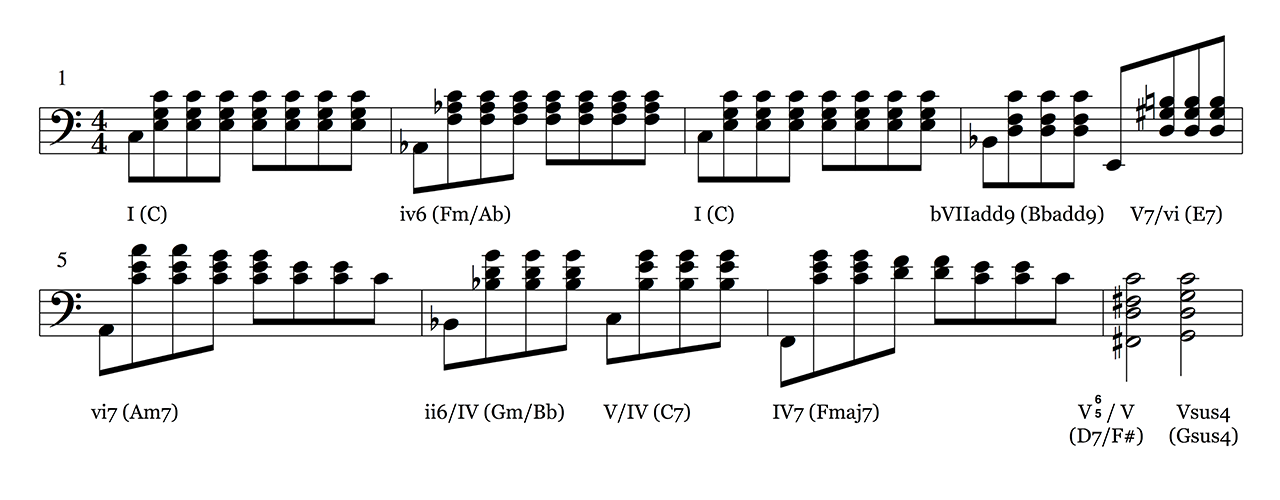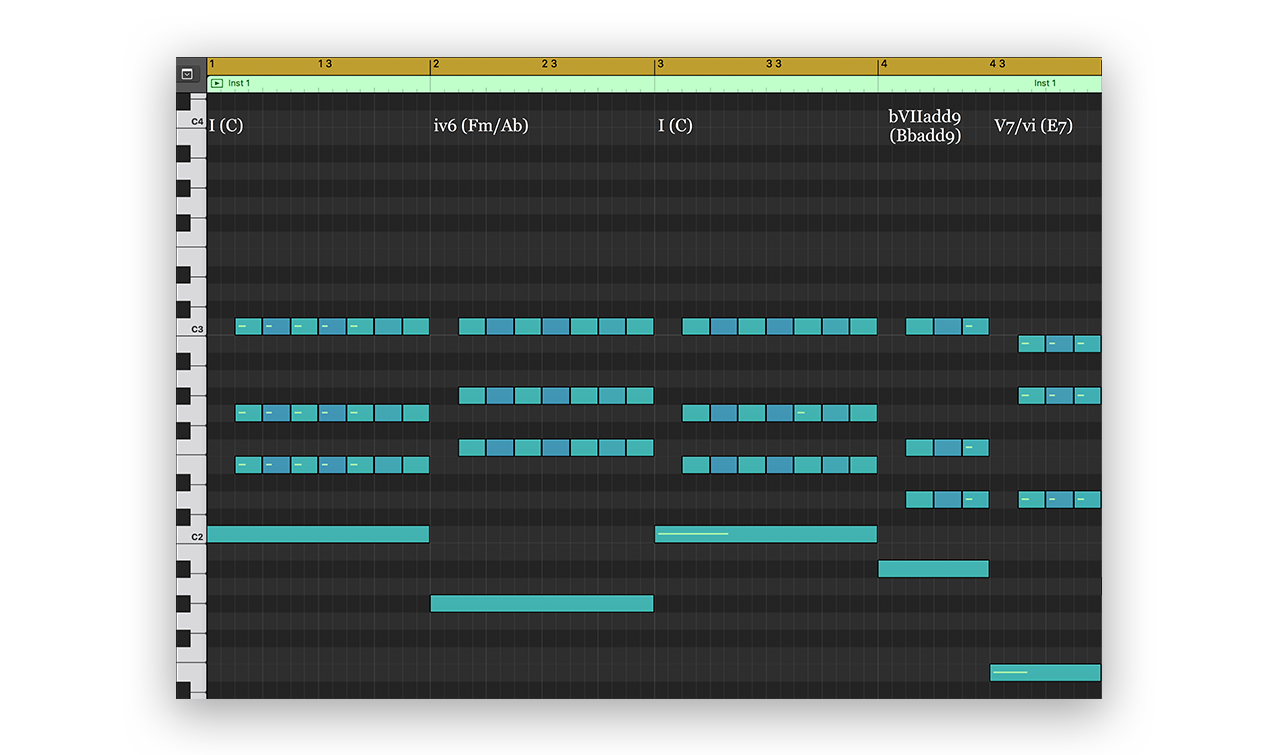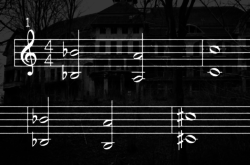Illustration: Fanny Luor
“Coco” is Pixar’s newest animated film, and it’s nothing short of breathtaking.
The movie urges us to explore questions of life, death, and family through a heartwarming narrative that’s elevated by stunning visuals and a gorgeous soundtrack. Music plays a pivotal role in the story itself, which follows a young boy who aspires to become a musician despite his family’s ban on music. One song in particular, “Remember Me,” recurs several times throughout the film, with each rendition holding new meaning and deepening our connection to the piece.
Today, we’ll explore three harmonic techniques that “Remember Me” uses in order to learn how we can add compelling emotional colors to our chord progressions. While there are several variations of the song, we’ll be focusing specifically on the first eight measures of the “Lullaby” version. A transcription of the melody and a functional/harmonic analysis of the chords are below in score notation as well as MIDI for less sheet music-minded people. Splice the project from the dna player below to listen to and experiment directly with the chord progression yourself.
This blog post mentions Splice Studio, which is no longer active. Learn more about the shutdown here.
The acoustic guitar used is AmpleSound’s Guitar Lite II, which is a free software instrument we featured in our 5 free VST series.


(Click and drag or swipe the image to scroll through measures for the MIDI notation)
Mode mixture
When you hear the first chord change in the song, isn’t there something irresistibly melancholy about the second chord? This chord, Fm/Ab (iv6), is an example of what’s known as mode mixture. Also known as a borrowed chord, mode mixture describes a chord that’s taken from a parallel key (we’ll get to what this means in a second). The first chord in the song is a C major chord, and this, along with the pitches in the melody (D, C, E, and G), lead our ears to believe that the song is in C major, and that the chords in the song will naturally fall under a set of diatonic chords that are built off of the root notes of the C major scale (C major, d minor, e minor, F major, G major, a minor, and a rarer b diminished). F minor isn’t in this list, so our ears might perk up from their autopilot-easy-listening mode when we hear it.
That said, it’s not a totally random chord from a distant harmonic land. Rather, it’s a chord that belongs to a different key that uses the same pitch (in this case, C) as its tonal center – this key is known as a parallel key. In this case, Fm/Ab belongs to our parallel minor key, c minor. The Ab differentiates the chord from the A natural in its diatonic counterpart, F major, and the fact that the Ab is placed in the bass draws attention to the fact that it’s a borrowed chord – it doesn’t try to sneak by, but rather unashamedly announces its presence. The use of this iv chord in a major key is perhaps the most common form of mode mixture, with countless pop songs using it for its heart-tugging effect – in the biography, “Many Years From Now,” Paul McCartney refers to the minor iv chord as “the normal thing to do.”
We aren’t limited to just borrowing from parallel major and minor keys – we can also borrow from modes. The Bbsus2 chord in the fourth measure might be interpreted as a borrowed chord from the mixolydian mode (if this is all mumbo-jumbo to you, here’s a tutorial to get you started on exploring modes). Mode mixture tremendously expands our harmonic toolbox, while also keeping our chord progressions logical and grounded.
Secondary dominance
Whether intellectually or emotionally, we’ve all experienced the feelings of tension and release in music. If you want to create this feeling compositionally, the easiest way to do so is by resolving a dominant chord with a subsequent tonic chord. This might sound complicated if you’re unfamiliar with music theory jargon, but it’s simple in practice – just try playing a G major chord (G, B, and D) followed by a C major chord (C, E, and G). Notice a satisfying resolution that hits with the C major chord? This feeling of resolution is a result of years of conditioning, where we’ve heard countless songs in Western music that use this chord relationship to signify a cadence, or the conclusion of a musical idea. In the key of C, the G chord is the only chord that can get this job done – and therefore, we call this chord the dominant chord of the key.
Secondary dominance takes the idea of using a dominant chord to the next level. We say to ourselves, “this feeling of tension and resolution is so great that I want to apply it to other moments of my chord progression that don’t include the tonic chord.” If you look at the D7/F# chord in the eighth measure, we see that again the chord deviates from its diatonic counterpart of d minor. The chord is actually the dominant chord of G, which is the chord that follows it. It’s as if for this measure only we’re in the key of G major instead of C major – this introduction of a temporary tonic is known as tonicization. By tonicizing the G chord with the secondary dominant chord of D7/F#, the song highlights the anticipation and arrival of the chord. This effect is most clear in this instance, but secondary dominance is sprinkled throughout the whole progression (the E7 serves as a secondary dominant to the subsequent Am7, and the C7 tonicizes the Fmaj7). If you want to emphasize a particular chord while also adding some spice, consider using secondary dominance in your own progressions.
Colorations
If you’re brain’s feeling a little fried at this point, this last point is a simple one – any triad can have notes added onto it to color its emotional impact. Adding the 7th to the chord is the easiest and most common thing to do, but other pitches are perfectly valid too. In the fourth measure, the Bbsus2 adds a C to the chord, allowing the pitch to carry from the previous bars just a little longer before resolving to the B natural in the following E7 chord. The unresolving fourth in Gsus4 also adds color to the chord and prevents the listener from the gratification of an unadulterated cadence, which leaves us feeling a little conflicted. This perfectly accompanies the emotional ambiguity of the overall song, which feels at once both hopeful and defeated, warm and lonely.
The big picture
Learning music theory is like adding colors to your palette – the more colors you have, the more you’re able to vividly express yourself. That said, if you add a bunch of colors left and right just because you can, your work is quickly going to become confusing and messy. While an intellectual understanding of theory can expand your musical possibilities astronomically, it’s important not to lose sight of what you’re trying to convey emotionally with your music. Theory can either serve or distract from your musical intentions, and it’s up to you as a composer to decide how to wield it.
January 29, 2018


